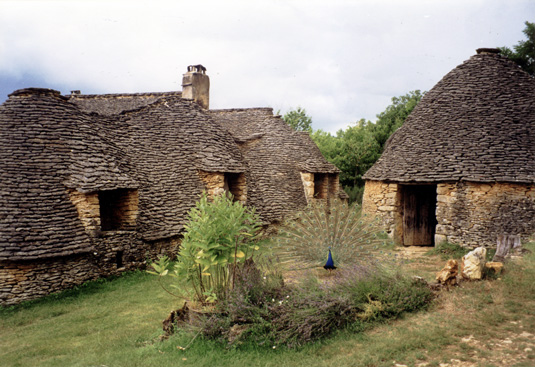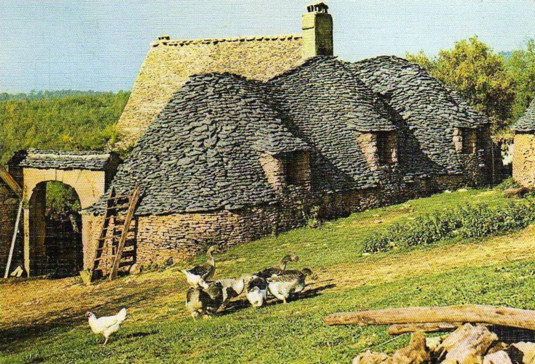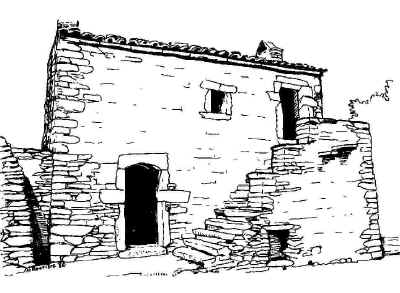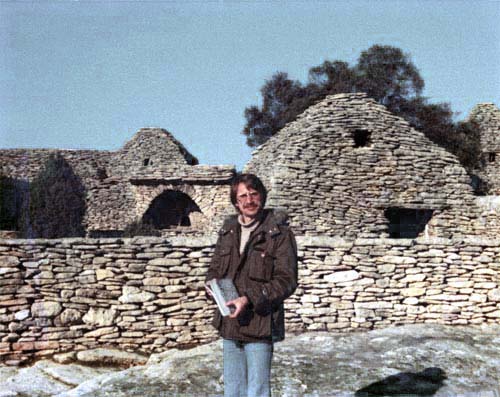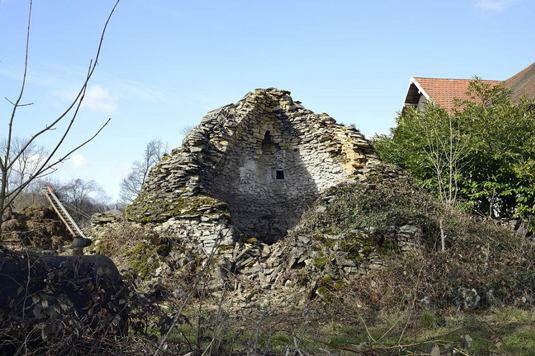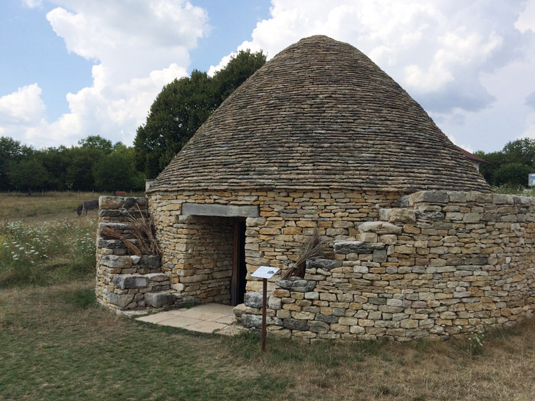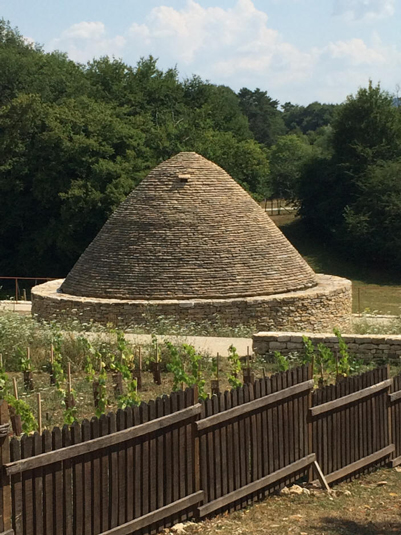|
OPEN AIR MUSEUMS OF DRY STONE ARCHITECTURE Christian Lassure
The "Huts at Le Breuil", as they are called by their owner, are to be found at a place called Calpalmas at Saint-André-d'Allas , 9 km from Sarlat and 12 km from Les Eyzies (*). They are agricultural buildings dating from the late 19th century or early 20th, whose particular features are their having a stone-tile covering over a dry-stone corbelled vault and their huddling together in groups. They form part of the nearby farm (consisting of a first-floor house with stone-tile roofing over wooden trusses and an enclosure whose entrance gateway is inscribed with the date 1841).
Now fully restored, the buildings have been classed as protected sites since 1968 and as Historic Monuments since May 15th, 1995. They can be visited all year round (but from November to May, booking beforehand is required, except during school holidays). The place has become well known not only through holiday postcards but through the cinema and television. In fact it served (before 1990) as a backdrop to such films as "Sleeping Beauty", "Jacquou le Croquant"(Stellio Lorenzi's TV serial ), "D'Artagnan" and even "Les Misérables" (Robert Hossein's film and TV serial).
There is absolutely no historical or archaeological proof that would allow the huts to be dated back to "the mists of time", a period that admittedly everyone is rather hazy about! Neither can their ownership be attributed to "the Benedictines of Sarlat up to the 14th century" – this is tantamount to confusing the site itself with the buildings that stand upon it. Owing to their forms and techniques, the stone huts achieve an outstanding architectural unity, a sure sign of their belonging to one and the same period or being the work of a single builder. Their architecture is the same as that of other stone huts with a conical or bell-shaped stone-tile roof to be seen in various places of the Sarladais region and dated to a construction campaign spanning the years 1750-1900. (*) According to some sources, the correct nameplace is "Le Bois Gris", but there is nothing in the Land Register to bear this out.
Sources : - Des 'bories' pour mémoire, La France agricole, September 28th, 1990 - website: http://www.cabanes-du-breuil.com/
To know more about the Huts at Le Breuil : - questions_et_reponses_2005_b.html#6_Audit - nouvelles_du_monde_2006_2.htm#15_Breuil - heurs_et_malheurs_des_edifices.htm#2_fabrique
This building is one of two "traditional" houses which stand in the Savournins hamlet, 3 km West of the village of Gordes, in the midst of local dry stone huts.
Located in the Southern part of the hamlet (the lower Savournins), the house today is part of an open-air museum complex that was saddled with the name of "Village des Bories" by its designer in the late 1970s. The other house, to be found in the Northern part of the hamlet (the higher Savournins), is privately owned. The architectural and morphological features of the edifice are clearly those of an upper-floor hall which was erected in two stages: - first of all, in the 18th century (as shown by the lintel with segmental arch above the lower entrance), a ground-floor building (possibly a barn or a house) was built, consisting of a single room, a purlin roof, and a side-wall entrance; - then, in the 19th century (as evinced by the straight lintel over the upper entrance), an upper floor was built, which entailed the placing of cross vaults at ground-floor level, the transfer of the purlin roof to the upper floor and the addition of an outside staircase running parallel to the long-wall façade; as a result, living quarters were moved to the upper floor, while the newly-vaulted ground floor was confined to production and storage. What used to be a single-storeyed affair had become an upper-floor dwelling.
To find out more about the so-called "Village des Bories" (the tourist attraction that replaced a hamlet known locally as "Les Cabanes") at Gordes, click on the above picture.
From 2015 up till 2017, the remains of an old, two-thirds collapsed, dry stone caborde located in the Tilleroyes district of Besançon were dismantled and then transported to the "musée des maisons franc-comtoises à Nancray" (museum of Franche-Comté houses at Nancray), in the Doubs département to be reassembled there. The project was carried out by the API 25 ("Association Patrimoine Insertion 25") society, a structure specialising in returning unemployed people to the workforce.
There is uncertainty as to the construction date of the Tilleroyes hut: The caborde reassembled at Nancray is a building with a cylindrical base body and a conical roofing rounded at the top under a covering of well-coursed stone tiles or lauses. Partially buried in the slope at the rear, the new edifice is surrounded by a buttress wall rising up to the level of the slightly overhanging eaves, except outside the entrance – where the buttress wall is interrupted – and on either side of the entrance, where two flights of steps have been built although none is visible in the photos of the original caborde.
With its 4.89m inside diameter and 5.80 m inside height, the stone edifice represents a 300-ton weight. The internal fittings are a vaulted recess (opposite the entrance), a niche, a squint, a smoke evacuation duct, a cistern, wooden beams supporting the planks of a floor which was accessed by a miller's ladder. Apparently, mortar was used on the exterior facing to level the counterwall as well as on the interior facing for the surbased arch of the vaulted recess.
For further information on this operation, please consult the report by Denis Dauphin (president of the API 25) and François Chopard (development manager) on "Le transfert d’une caborde des Tilleroyes au musée de Nancray" ("the transfer of a caborde from Tilleroyes to the Nancray Museum"), in Barbizier journal, N. 44, 2018, pp. 77-100.
More pages about dry stone cabordes in this site
Liste des édifices en pierre sèche protégés : Doubs
Cabane au lieu-dit Montboucons à Besançon
To print, use landscape mode © CERAV To be referenced as : Christian Lassure page d'accueil sommaire inventaire
|

